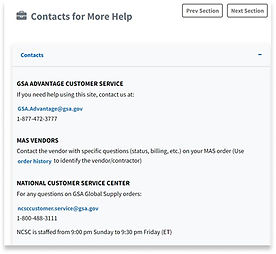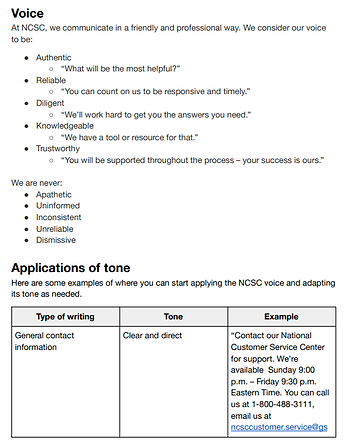GSA contact information
Working with stakeholders to reduce redundant customer contact information by 49% across four websites

Summary
As the Content Design co-lead on this project, we streamlined redundant and outdated customer contact information by 49% across four public-facing GSA websites.
Intro
The General Services Administration (GSA) is a federal agency that provides the tools, technology, and services other government agencies need to serve the public. The National Customer Service Center (NCSC) at GSA provides support to agency customers looking to purchase through GSA.
Challenge
Although contact information was usually available across most GSA websites, there were challenges in maintaining its consistency and accuracy. This made it hard for users to know who to contact for help.
No single source of truth for contact information
-
Most GSA websites were managed by different owners and had their variation of contact information
-
No efficient method to communicate with website owners if the NCSC had operational changes, such as phone number
Redundant, outdated, or trivial information
-
Some contact pages had little context on what support was available
-
Other pages had excessive but inaccurate or redundant information



Across several GSA websites, customer contact information was inconsistently formatted and located
Team
-
Content Design co-lead: Vy Doan
-
In collaboration with NCSC stakeholders, GSA website managers, and the Office of Strategic Communication (OSC), which provides communication services for GSA as an agency
Focus areas
As a co-lead, I specifically focused on:
-
Leading user research planning and synthesis
-
Creating a voice and tone workshop and accompanying style guide
-
Developing content prototypes and aligning them with the GSA style guide
-
Coordinating with individual website owners and the agency-wide communications office to implement content recommendations
How I helped
Content analysis
Figuring out what content was available and what to keep, cut, or rewrite
My co-lead and I inherited some discovery work that our contractors had done to narrow down the scope of this project since GSA has 160+ websites. We came up with a list of seven websites that were relevant to the project goals and within the NCSC’s influence.
I did an initial audit of all seven websites, which helped shaped our priorities and later informed what we tested with users.

Content audit focused on readability, web page performance, accessibility, and content discrepancies between sites
User research
Understanding the GSA customer support experience
Taking a step back, we wanted to better understand how and why people seek help from GSA, and what gets in their way. I created the user research plan and co-facilitated several sessions.
I led a synthesis of the interviews, identifying key patterns that informed our design decisions—like eliminating internal agency language. We also learned that customers didn’t recognize differences between GSA sites—they saw the agency as one entity and expected consistent help no matter where they landed.
My co-lead then suggested building out a card containing NCSC contact information that could be reused across different websites.

User research with several federal agency customers from a range of roles
Voice and tone
Defining how the NCSC speaks to customers
To create this reusable content card, we first had to tighten up the voice and tone of how customer support information was currently written. During the audit, I noticed that contact information lacked context and was internally organized based on GSA’s needs instead of their customers’.
I adapted a voice and tone workshop from another team and co-facilitated the session with NCSC stakeholders. I defined the differences between voice and tone, gave examples of where they occur, and had the NCSC team describe how they want their customers to feel after each interaction.

The NCSC voice is “authentic”, “reliable”, and “diligent” – showing how much the team cares about positive customer experiences
Style guide
Documenting standards for consistent future content edits
Findings from this workshop were incorporated into an initial style guide addendum that I created for their team, which my coworker later expanded upon. This guide was built on GSA’s broader style guide and included voice and tone examples, writing tips, and use cases specific to customer service.


The style guide is meant to be a living document the NCSC can use as the needs of their office, customers, and content ecosystem evolves
Reusable, scalable content
Documenting standards for consistent future content edits
Taking insights from the Nielsen Norman Group, the reusable content card included:

The reusable content card is succinct but informative and flexible enough to be implemented in a wide variety of settings
Implementation
I met with each of the website managers to walk them through our content recommendations, explain the rationale for the changes, and negotiate feasible updates. This relationship-building was critical to getting the contact card implemented across such a fragmented content ecosystem. Here are some before and after examples of the implemented changes.

Before: No email option and little context as to why someone may want to reach out

After: Key channels highlighted within context

Before: Page used internal GSA language and contained links to lists of individual points of contact

After: Contact information points to a centralized source
Results
Enhanced consistency and accuracy of customer contact information
-
Collectively reduced redundant, outdated, and trivial content by 49% across four websites
-
Customers now had a “one-stop shop” for support information no matter which of the four sites they visited
-
NCSC team appreciated having a single, trustworthy source of contact information that they can continually update as needed
This work also led to conversations about applying the contact card across more GSA sites—and sparked interest in expanding content governance efforts for other high-traffic pages.
Future considerations
While this project received buy-in from most stakeholders, I would have liked to explore how to bring their perspectives in earlier in the process to imagine what a more holistic GSA customer support journey could look like.
Digging into NCSC's baseline call volume and types of inquiries could have also helped us demonstrate more tangible impacts of our work.